@HarryUp
2019-06-26T03:35:01.000000Z
字数 17992
阅读 1930
Tutorial on tensorflow usage
Outline
- Brief introduction to tensorflow
- Start from a simple CNN
- Utilities
- Advanced API
- Dynamic mode
- Appendixes
1. Brief introduction to tensorflow
1.1. Architectures of CPU and GPU
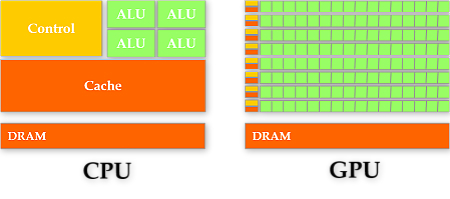
- CPU: master in cache and flow control
- GPU: master in numerical calculation
1.2. Tensorflow architecture
1.2.1. The programming stack
- An open-source software library
- Run on multiple (distri) CPUs and GPUs (TPUs)
- Support Python, C++, JAVA, Go

1.2.2. Units
- Perform computing tasks as a graph
- Execute the graph in the context of session
- Represent data as tensor
- Maintaining states through variable
- Use feed and fetch to assign values to arbitrary operation or obtain values from it
import tensorflow as tf# Creat a variable and initialize it as scalar 0state = tf.Variable(0, name="counter")# To creat an op, aiming to increase state by 1one = tf.placeholder(tf.int32, shape=None, name='one')new_value = tf.add(state, one)update = tf.assign(state, new_value)# After the graph startup, variables must be initialized# First, add an `initializer` op into the graphinit_op = tf.global_variables_initializer()# Start the graph, run opswith tf.Session() as sess:# Run 'init' opsess.run(init_op)# Print the initial value of 'state'print(sess.run(state))# Run op to update 'state' and print 'state'for _ in range(3):sess.run(update, feed_dict={one:1})print(sess.run(state))# Output:# 0# 1# 2# 3
1.2.3. GPU usage
- Visual studio (2015)
- python 2.7 or 3.5+
- CUDA and cuDNN
- pip or whl tensorflow-gpu
2. Start from a simple CNN
2.1. Convolutional neural network model

2.1.1. Convolution
- convolutional kernel
- stride
- padding
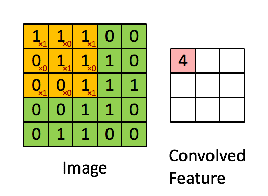
2.1.2. Pooling
- max pooling
- mean pooling
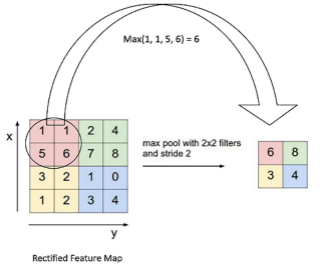
2.2. MNIST database
- 60,000 examples for training and 10,000 examples for testing
- size-normalized and centered in a fixed-size image (28x28 pixels)
- flattened and converted to a 1-D numpy array of 784 features
tensorflow.examples.tutorials.mnist

2.3. Code implementation
2.3.1. Preliminary
from __future__ import division, print_function, absolute_importimport tensorflow as tf# Import MNIST datafrom tensorflow.examples.tutorials.mnist import input_datamnist = input_data.read_data_sets("/tmp/data/", one_hot=True)# Training Parameterslearning_rate = 0.001num_steps = 500batch_size = 128display_step = 10# Network Parametersnum_input = 784 # MNIST data input (img shape: 28*28)num_classes = 10 # MNIST total classes (0-9 digits)dropout = 0.75 # Dropout, probability to keep units# tf Graph inputX = tf.placeholder(tf.float32, [None, num_input])Y = tf.placeholder(tf.float32, [None, num_classes])keep_prob = tf.placeholder(tf.float32) # dropout (keep probability)
2.3.2. Creat model architecture
# Create some wrappers for simplicitydef conv2d(x, W, b, strides=1):# Conv2D wrapper, with bias and relu activationx = tf.nn.conv2d(x, W, strides=[1, strides, strides, 1], padding='SAME')x = tf.nn.bias_add(x, b)return tf.nn.relu(x)def maxpool2d(x, k=2):# MaxPool2D wrapperreturn tf.nn.max_pool(x, ksize=[1, k, k, 1], strides=[1, k, k, 1],padding='SAME')# Create modeldef conv_net(x, weights, biases, dropout):# MNIST data input is a 1-D vector of 784 features (28*28 pixels)# Reshape to match picture format [Height x Width x Channel]# Tensor input become 4-D: [Batch Size, Height, Width, Channel]x = tf.reshape(x, shape=[-1, 28, 28, 1])# Convolution Layerconv1 = conv2d(x, weights['wc1'], biases['bc1'])# Max Pooling (down-sampling)conv1 = maxpool2d(conv1, k=2)# Convolution Layerconv2 = conv2d(conv1, weights['wc2'], biases['bc2'])# Max Pooling (down-sampling)conv2 = maxpool2d(conv2, k=2)# Fully connected layer# Reshape conv2 output to fit fully connected layer inputfc1 = tf.reshape(conv2, [-1, weights['wd1'].get_shape().as_list()[0]])fc1 = tf.add(tf.matmul(fc1, weights['wd1']), biases['bd1'])fc1 = tf.nn.relu(fc1)# Apply Dropoutfc1 = tf.nn.dropout(fc1, dropout)# Output, class predictionout = tf.add(tf.matmul(fc1, weights['out']), biases['out'])return out
2.3.3. Construct model graph
# Store layers weight & biasweights = {# 5x5 conv, 1 input, 32 outputs'wc1': tf.Variable(tf.random_normal([5, 5, 1, 32])),# 5x5 conv, 32 inputs, 64 outputs'wc2': tf.Variable(tf.random_normal([5, 5, 32, 64])),# fully connected, 7*7*64 inputs, 1024 outputs'wd1': tf.Variable(tf.random_normal([7*7*64, 1024])),# 1024 inputs, 10 outputs (class prediction)'out': tf.Variable(tf.random_normal([1024, num_classes]))}biases = {'bc1': tf.Variable(tf.random_normal([32])),'bc2': tf.Variable(tf.random_normal([64])),'bd1': tf.Variable(tf.random_normal([1024])),'out': tf.Variable(tf.random_normal([num_classes]))}# Construct modellogits = conv_net(X, weights, biases, keep_prob)prediction = tf.nn.softmax(logits)# Define loss and optimizerloss_op = tf.reduce_mean(tf.nn.softmax_cross_entropy_with_logits(logits=logits, labels=Y))optimizer = tf.train.AdamOptimizer(learning_rate=learning_rate)train_op = optimizer.minimize(loss_op)# Evaluate modelcorrect_pred = tf.equal(tf.argmax(prediction, 1), tf.argmax(Y, 1))accuracy = tf.reduce_mean(tf.cast(correct_pred, tf.float32))# Initialize the variables (i.e. assign their default value)init = tf.global_variables_initializer()
2.3.4. Session run
# Start trainingwith tf.Session() as sess:# Run the initializersess.run(init)for step in range(1, num_steps+1):batch_x, batch_y = mnist.train.next_batch(batch_size)# Run optimization op (backprop)sess.run(train_op, feed_dict={X: batch_x, Y: batch_y, keep_prob: dropout})if step % display_step == 0 or step == 1:# Calculate batch loss and accuracyloss, acc = sess.run([loss_op, accuracy], feed_dict={X: batch_x,Y: batch_y,keep_prob: 1.0})print("Step " + str(step) + ", Minibatch Loss= " + \"{:.4f}".format(loss) + ", Training Accuracy= " + \"{:.3f}".format(acc))print("Optimization Finished!")# Calculate accuracy for 256 MNIST test imagesprint("Testing Accuracy:", \sess.run(accuracy, feed_dict={X: mnist.test.images[:256],Y: mnist.test.labels[:256],keep_prob: 1.0}))# Testing Accuracy: 0.976562
3. Utilities
3.1. Save and restore model
# 'Saver' op to save and restore all the variablessaver = tf.train.Saver()# Save model weights to disksave_path = saver.save(sess, model_path)print("Model saved in file: %s" % save_path)# Restore model weights from previously saved modelload_path = saver.restore(sess, model_path)print("Model restored from file: %s" % save_path)
3.2. Visualization - tensorboard basics
# Construct model and encapsulating all ops into scopes, making# Tensorboard's Graph visualization more convenientwith tf.name_scope('Model'):# Modelpred = tf.nn.softmax(tf.matmul(x, W) + b) # Softmaxwith tf.name_scope('Loss'):# Minimize error using cross entropycost = tf.reduce_mean(-tf.reduce_sum(y * tf.log(pred), reduction_indices=1))with tf.name_scope('SGD'):# Gradient Descentoptimizer = tf.train.GradientDescentOptimizer(learning_rate).minimize(cost)with tf.name_scope('Accuracy'):# Accuracyacc = tf.equal(tf.argmax(pred, 1), tf.argmax(y, 1))acc = tf.reduce_mean(tf.cast(acc, tf.float32))# Initializing the variablesinit = tf.global_variables_initializer()# Create a summary to monitor cost tensortf.summary.scalar("loss", cost)# Create a summary to monitor accuracy tensortf.summary.scalar("accuracy", acc)# Merge all summaries into a single opmerged_summary_op = tf.summary.merge_all()# Start Trainingwith tf.Session() as sess:sess.run(init)# op to write logs to Tensorboardsummary_writer = tf.summary.FileWriter(logs_path, graph=tf.get_default_graph())# ...# Run optimization op (backprop), cost op (to get loss value)# and summary nodes_, c, summary = sess.run([optimizer, cost, merged_summary_op],feed_dict={x: batch_xs, y: batch_ys})# Write logs at every iterationsummary_writer.add_summary(summary, epoch * total_batch + i)# Run the command line:# --> tensorboard --logdir=/tmp/tensorflow_logs# Then open http://0.0.0.0:6006/ into your web browser
Loss and Accuracy Visualization

Graph Visualization
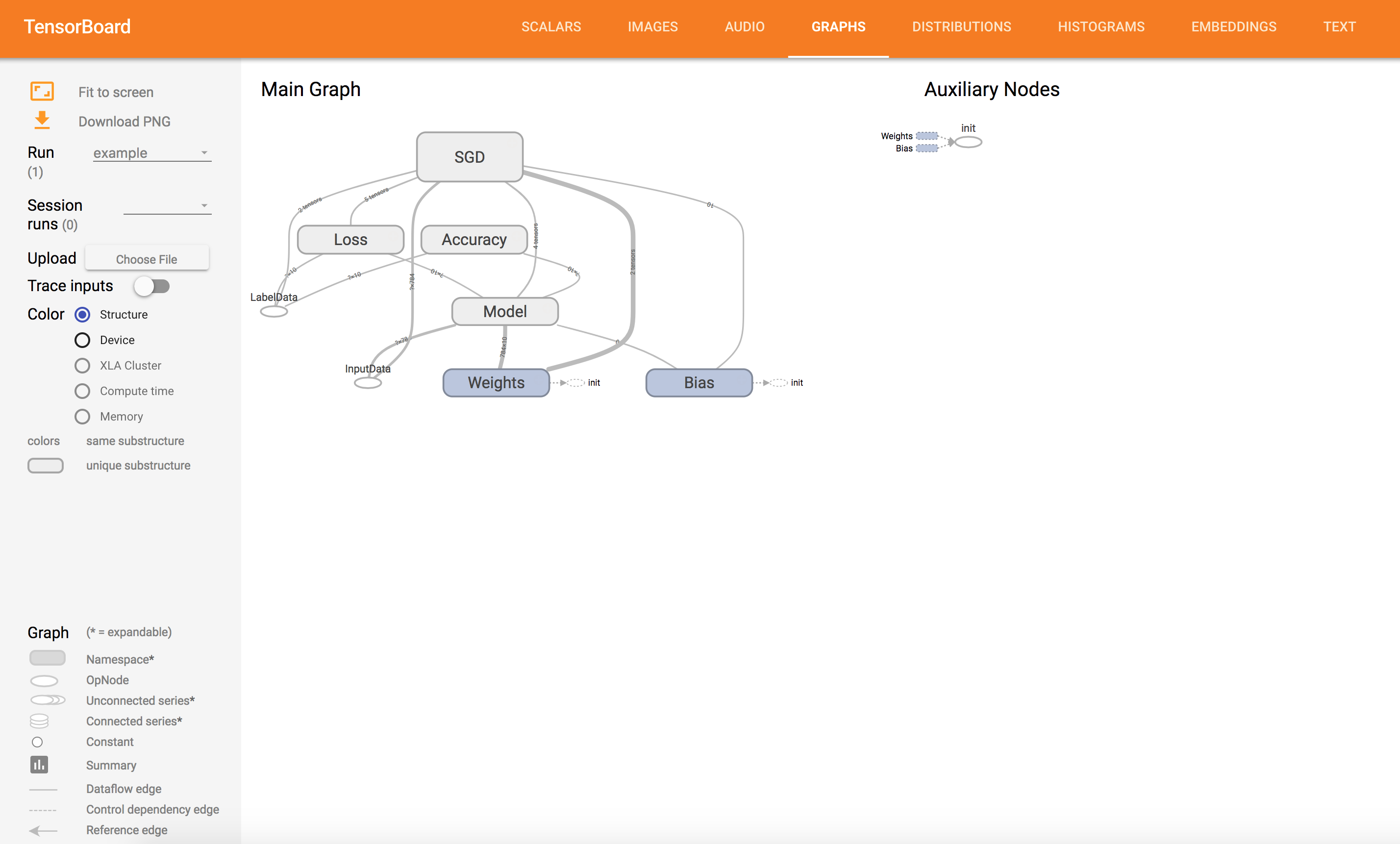
3.3. Visualization - tensorboard advanced
with tf.name_scope('SGD'):# Gradient Descentoptimizer = tf.train.GradientDescentOptimizer(learning_rate)# Op to calculate every variable gradientgrads = tf.gradients(loss, tf.trainable_variables())grads = list(zip(grads, tf.trainable_variables()))# Op to update all variables according to their gradientapply_grads = optimizer.apply_gradients(grads_and_vars=grads)# Create summaries to visualize weightsfor var in tf.trainable_variables():tf.summary.histogram(var.name, var)# Summarize all gradientsfor grad, var in grads:tf.summary.histogram(var.name + '/gradient', grad)
Computation Graph Visualization
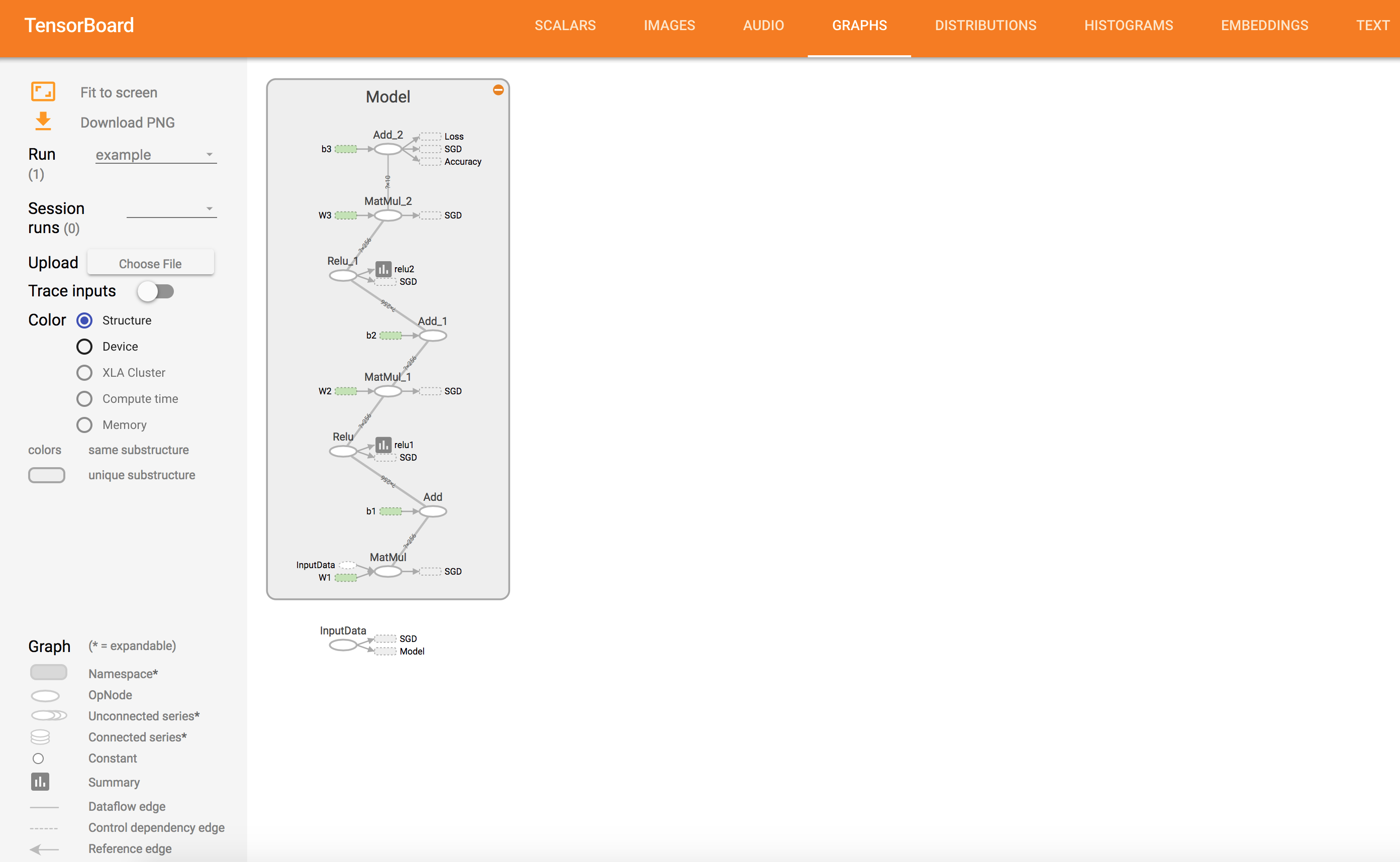
Weights and Gradients Visualization
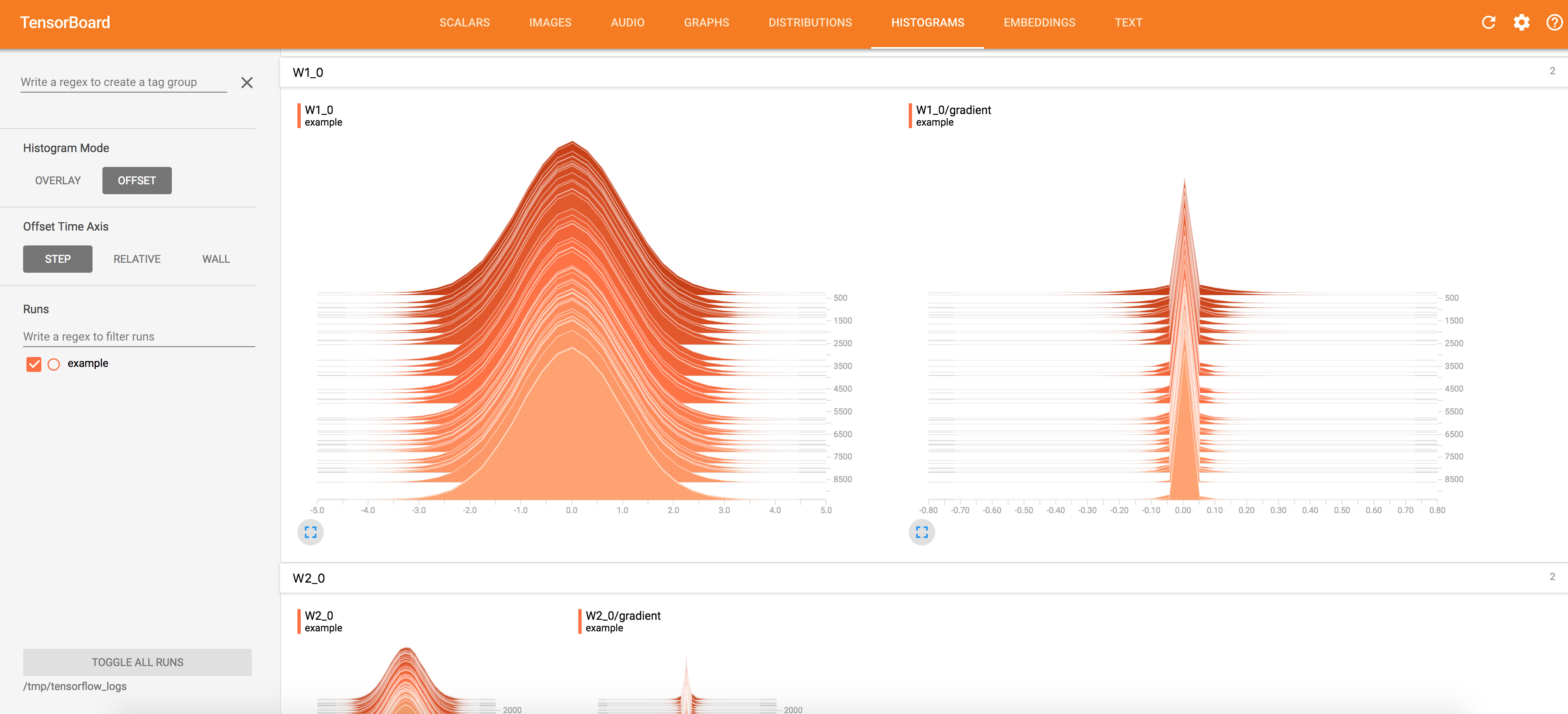
Activations Visualization
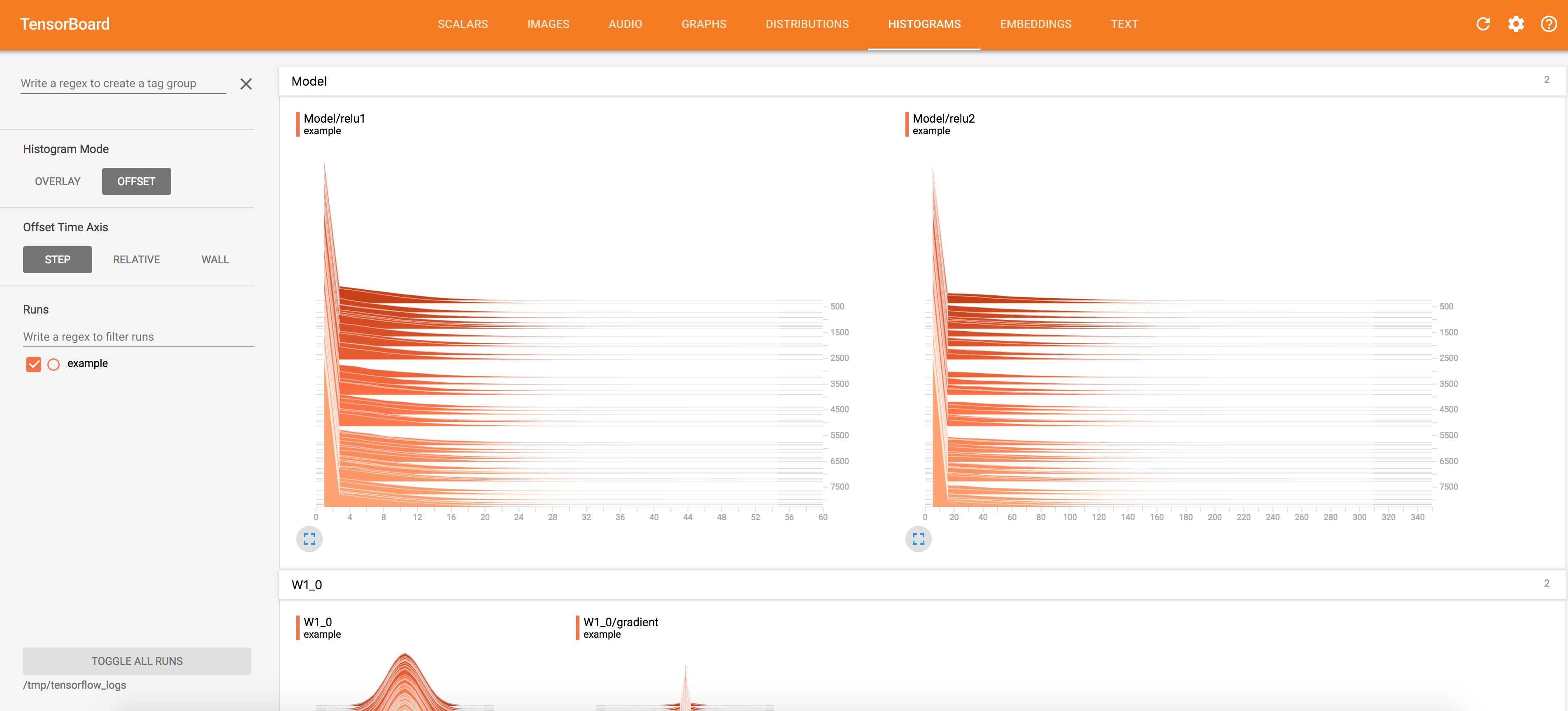
4. Advanced APIs
4.1. High-level package
4.1.1. Keras
from tensorflow import keras
# Sequential modelmodel = keras.Sequential()# Adds a densely-connected layer with 64 units to the model:model.add(keras.layers.Dense(64, activation='relu'))# Add another:model.add(keras.layers.Dense(64, activation='relu'))# Add a softmax layer with 10 output units:model.add(keras.layers.Dense(10, activation='softmax'))
# Set up trainingmodel.compile(optimizer=tf.train.AdamOptimizer(0.001),loss='categorical_crossentropy',metrics=['accuracy'])# Input NumPy datamodel.fit(data, labels, epochs=10, batch_size=32)# Evaluate and predictmodel.evaluate(x, y, batch_size=32)model.predict(x, batch_size=32)
from keras.applications import inception_v3
4.1.2. Slim (Tensorlayer)
import tensorflow.contrib.slim as slim
with slim.arg_scope([slim.conv2d], padding='SAME',weights_initializer=tf.truncated_normal_initializer(stddev=0.01)weights_regularizer=slim.l2_regularizer(0.0005)):net = slim.conv2d(inputs, 64, [11, 11], scope='conv1')net = slim.conv2d(net, 128, [11, 11], padding='VALID', scope='conv2')net = slim.conv2d(net, 256, [11, 11], scope='conv3')
net = ...net = slim.conv2d(net, 256, [3, 3], scope='conv3_1')net = slim.conv2d(net, 256, [3, 3], scope='conv3_2')net = slim.conv2d(net, 256, [3, 3], scope='conv3_3')net = slim.max_pool2d(net, [2, 2], scope='pool2')# using slim.repeatnet = slim.repeat(net, 3, slim.conv2d, 256, [3, 3], scope='conv3')net = slim.max_pool2d(net, [2, 2], scope='pool2')
x = slim.fully_connected(x, 32, scope='fc/fc_1')x = slim.fully_connected(x, 64, scope='fc/fc_2')x = slim.fully_connected(x, 128, scope='fc/fc_3')# using slim.stackslim.stack(x, slim.fully_connected, [32, 64, 128], scope='fc')
4.2. Estimator
# Define the input function for traininginput_fn = tf.estimator.inputs.numpy_input_fn(x={'images': mnist.train.images}, y=mnist.train.labels,batch_size=batch_size, num_epochs=None, shuffle=True)
# Define the neural networkdef neural_net(x_dict):# TF Estimator input is a dict, in case of multiple inputsx = x_dict['images']# Hidden fully connected layer with 256 neuronslayer_1 = tf.layers.dense(x, n_hidden_1)# Hidden fully connected layer with 256 neuronslayer_2 = tf.layers.dense(layer_1, n_hidden_2)# Output fully connected layer with a neuron for each classout_layer = tf.layers.dense(layer_2, num_classes)return out_layer
# Define the model function (following TF Estimator Template)def model_fn(features, labels, mode):# Build the neural networklogits = neural_net(features)# Predictionspred_classes = tf.argmax(logits, axis=1)pred_probas = tf.nn.softmax(logits)# If prediction mode, early returnif mode == tf.estimator.ModeKeys.PREDICT:return tf.estimator.EstimatorSpec(mode, predictions=pred_classes)# Define loss and optimizerloss_op = tf.reduce_mean(tf.nn.sparse_softmax_cross_entropy_with_logits(logits=logits, labels=tf.cast(labels, dtype=tf.int32)))optimizer = tf.train.GradientDescentOptimizer(learning_rate=learning_rate)train_op = optimizer.minimize(loss_op, global_step=tf.train.get_global_step())# Evaluate the accuracy of the modelacc_op = tf.metrics.accuracy(labels=labels, predictions=pred_classes)# TF Estimators requires to return a EstimatorSpec, that specify# the different ops for training, evaluating, ...estim_specs = tf.estimator.EstimatorSpec(mode=mode,predictions=pred_classes,loss=loss_op,train_op=train_op,eval_metric_ops={'accuracy': acc_op})return estim_specs
# Build the Estimatormodel = tf.estimator.Estimator(model_fn)# Train the Modelmodel.train(input_fn, steps=num_steps)
Checkpoint
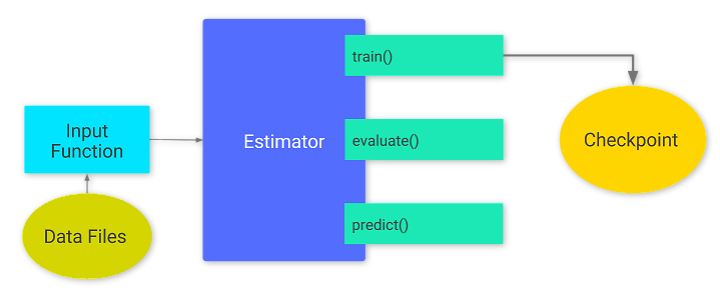
- Estimators automatically write the following to disk:
- checkpoints, which are versions of the model created during training.
- event files, which contain information that TensorBoard uses to create visualizations.
my_checkpointing_config = tf.estimator.RunConfig(save_checkpoints_secs = 20*60, # Save checkpoints every 20 minutes.keep_checkpoint_max = 10, # Retain the 10 most recent checkpoints.)classifier = tf.estimator.DNNClassifier(feature_columns=my_feature_columns,hidden_units=[10, 10],n_classes=3,model_dir='models/iris',config=my_checkpointing_config)
4.3. Dataset
# Create a dataset tensor from the images and the labelsdataset = tf.contrib.data.Dataset.from_tensor_slices((mnist.train.images, mnist.train.labels))# Create batches of datadataset = dataset.batch(batch_size)# Create an iterator, to go over the datasetiterator = dataset.make_initializable_iterator()# It is better to use 2 placeholders, to avoid to load all data into memory,# and avoid the 2Gb restriction length of a tensor._data = tf.placeholder(tf.float32, [None, n_input])_labels = tf.placeholder(tf.float32, [None, n_classes])# Initialize the iteratorsess.run(iterator.initializer, feed_dict={_data: mnist.train.images,_labels: mnist.train.labels})# Neural Net InputX, Y = iterator.get_next()
5. Dynamic mode
5.1. Dynamic graph
- Static declaration VS Dynamic declaration
- Declaration & Execution
- Virtual computing graph & Entity computing graph
- Layout, memory allocation, execution: Global VS Local
- Efficiency VS Friendly coding
- Multi-structure input problem
- TensorFlow Fold via Dynamic Batching
- Simulate dynamic graphs with arbitrary shape and size
- https://zhuanlan.zhihu.com/p/25216368
- (Pytorch is also quite popular in academic researches)
5.2. Eager mode
Eager API basics
# Set Eager APItf.enable_eager_execution()tfe = tf.contrib.eager# Run the operation without the need for tf.Sessiona = tf.constant(2)b = tf.constant(3)c = a + bd = a * b# Full compatibility with Numpya = tf.constant([[2., 1.],[1., 0.]], dtype=tf.float32)b = np.array([[3., 0.],[5., 1.]], dtype=np.float32)c = a + bd = tf.matmul(a, b)# Auto differentiationdef square(x):return tf.multiply(x, x)grad = tfe.gradients_function(square)square(3.) # => 9.0grad(3.) # => [6.0]
A toy example
class Model(tf.keras.Model):def __init__(self):super(Model, self).__init__()self.W = tfe.Variable(5., name='weight')self.B = tfe.Variable(10., name='bias')def call(self, inputs):return inputs * self.W + self.B# A toy dataset of points around 3 * x + 2NUM_EXAMPLES = 2000training_inputs = tf.random_normal([NUM_EXAMPLES])noise = tf.random_normal([NUM_EXAMPLES])training_outputs = training_inputs * 3 + 2 + noise# The loss function to be optimizeddef loss(model, inputs, targets):error = model(inputs) - targetsreturn tf.reduce_mean(tf.square(error))def grad(model, inputs, targets):with tf.GradientTape() as tape:loss_value = loss(model, inputs, targets)return tape.gradient(loss_value, [model.W, model.B])# Define:# 1. A model.# 2. Derivatives of a loss function with respect to model parameters.# 3. A strategy for updating the variables based on the derivatives.model = Model()optimizer = tf.train.GradientDescentOptimizer(learning_rate=0.01)print("Initial loss: {:.3f}".format(loss(model, training_inputs, training_outputs)))# Training loopfor i in range(300):grads = grad(model, training_inputs, training_outputs)optimizer.apply_gradients(zip(grads, [model.W, model.B]),global_step=tf.train.get_or_create_global_step())if i % 20 == 0:print("Loss at step {:03d}: {:.3f}".format(i, loss(model, training_inputs, training_outputs)))print("Final loss: {:.3f}".format(loss(model, training_inputs, training_outputs)))print("W = {}, B = {}".format(model.W.numpy(), model.B.numpy()))
Save and restore in eager mode
model = MyModel()optimizer = tf.train.AdamOptimizer(learning_rate=0.001)checkpoint_dir = ‘/path/to/model_dir’checkpoint_prefix = os.path.join(checkpoint_dir, "ckpt")root = tfe.Checkpoint(optimizer=optimizer,model=model,optimizer_step=tf.train.get_or_create_global_step())root.save(file_prefix=checkpoint_prefix)# orroot.restore(tf.train.latest_checkpoint(checkpoint_dir))
Tensorboard in eager mode
writer = tf.contrib.summary.create_file_writer(logdir)global_step=tf.train.get_or_create_global_step() # return global step varwriter.set_as_default()for _ in range(iterations):global_step.assign_add(1)# Must include a record_summaries methodwith tf.contrib.summary.record_summaries_every_n_global_steps(100):# your model code goes heretf.contrib.summary.scalar('loss', loss)...
Use eager execution in a graph environment
def my_py_func(x):x = tf.matmul(x, x) # You can use tf opsprint(x) # but it's eager!return xwith tf.Session() as sess:x = tf.placeholder(dtype=tf.float32)# Call eager function in graph!pf = tfe.py_func(my_py_func, [x], tf.float32)sess.run(pf, feed_dict={x: [[2.0]]}) # [[4.0]]
5.3. AutoGraph (beta)
pip install -U tf-nightly
from tensorflow.contrib import autograph as ag
Using with annotations
@ag.convert()def f(x):if x < 0:x = -xreturn x
with tf.Graph().as_default():x = tf.constant(-1)y = f(x)with tf.Session() as sess:print(sess.run(y))# Output: 1
Using the functional API
converted_f = ag.to_graph(f)print(converted_f(tf.constant(-1)))# Output: Tensorprint(f(-1))# Output: 1
print(ag.to_code(f))# Output: <Python and TensorFlow code>
6. Appendixs
6.1. Tricks
Learning rate decay
global_step = tf.Variable(0, trainable=False)starter_learning_rate = 0.1learning_rate = tf.train.exponential_decay(starter_learning_rate, global_step,100000, 0.96)# Passing global_step to minimize() will increment it at each step.learning_step = (tf.train.GradientDescentOptimizer(learning_rate).minimize(...my loss..., global_step=global_step))
decayed_learning_rate = learning_rate *decay_rate ^ (global_step / decay_steps)
Find anywhere 'nan' is raised
check= tf.add_check_numerics_ops...sess.run([check, ...])
Filter which layer to be freezed through variable names
tvars = tf.trainable_variables()tvars = [v for v in tvars if 'frozen' not in v.name]grads = tf.gradients(loss, tvars)
Leverage Timeline to analyse time consumption
run_metadata = tf.RunMetadata()run_options = tf.RunOptions(trace_level=tf.RunOptions.FULL_TRACE)config = tf.ConfigProto(graph_options=tf.GraphOptions(optimizer_options=tf.OptimizerOptions(opt_level=tf.OptimizerOptions.L0)))with tf.Session(config=config) as sess:c_np = sess.run(c,options=run_options,run_metadata=run_metadata)tl = timeline.Timeline(run_metadata.step_stats)ctf = tl.generate_chrome_trace_format()with open('timeline.json','w') as wd:wd.write(ctf)# Open chrome and type: chrome://tracing# and import timeline.json
......
6.2. Extended libraries
Cupy, Dask
# 在一个cpu上跑import numpy as npx = np.random.random((2,3))y = x.T.dot(np.log(x) + 1)z = y - y.mean(axis=0)print(z[:5])# 在GPU上跑import cupy as cpx = cp.random.random((2,3))y = x.T.dot(cp.log(x) + 1)z = y - y.mean()print(z[:5].get())# 在许多cpu上跑import dask.array as dax = da.random.random((2,3))y = x.T.dot(da.log(x) + 1)z = y - y.mean(axis=0)print(z[:5].compute())
Ray (under development)
- Ray is a Python-based distributed execution engine.
- Developed by RISELab (AMPLab as the predecessor).
- The same code can be run on a single machine to achieve efficient multiprocessing,
and it can be used on a cluster for large computations. - Asynchronous parallel.
- scheduling latency:
- 100us level (Ray) vs 100ms level (Spark)
- dynamic tasks
def add1(a, b):return a + b@ray.remotedef add2(a, b):return a + bx_id = add2.remote(1, 2)ray.get(x_id) # 3
import timedef f1():time.sleep(1)@ray.remotedef f2():time.sleep(1)# The following takes ten seconds.[f1() for _ in range(10)]# The following takes one second (assuming the system has at least ten CPUs).ray.get([f2.remote() for _ in range(10)])
@ray.remotedef f(x):return x + 1x = f.remote(0)y = f.remote(x)z = f.remote(y)ray.get(z) # 3
TensorLy
......
Suggestion
Tensorflow + Slim (TensorLayer)
Estimator + Checkpoint + TensorBoard
Eager execution if you want
